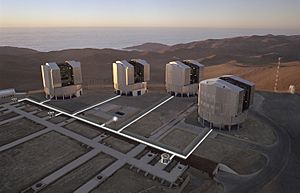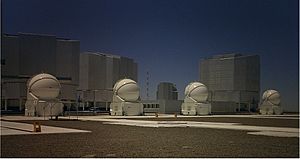Very Large Telescope facts for kids
Quick facts for kids Very Large Telescope |
|

The four Unit Telescopes that form the VLT together with the Auxiliary Telescopes
|
|
| Organization | European Southern Observatory (ESO) |
|---|---|
| Location | Paranal Observatory, Atacama desert, Chile |
| Altitude | 2,635 m |
| Weather | >340 clear nights/year |
| Wavelength | 300 nm – 20 μm (visible, near- and mid-infrared) |
| First light | 1998 (for the first Unit Telescope) |
| Telescope style | Ritchey-Chrétien |
| Diameter | 4 x 8.2-metre Unit Telescopes (UT), plus 4 x 1.8-metre moveable Auxiliary Telescopes (AT) |
| Mounting | Altazimuth |
The Very Large Telescope (VLT) is a powerful telescope built and run by the European Southern Observatory (ESO). You can find it high up on Cerro Paranal mountain in the Atacama Desert in northern Chile. It helps scientists learn more about space.
Contents
What is the VLT?
The VLT is made of four big telescopes working together. Each one has a main mirror that is 8.2 meters (about 27 feet) wide. These telescopes can work on their own, or they can join forces. When they work together, they can see incredibly clear details.
The observatory also has four smaller, movable telescopes. These are called Auxiliary Telescopes (ATs). Each AT has a mirror 1.8 meters (about 6 feet) wide.
How the VLT Sees the Universe
The VLT can see different kinds of light from space. It works with visible light, which is what our eyes can see. It also works with infrared wavelengths, which is like heat light.
Each of the main telescopes can spot objects that are four billion times fainter than what you can see with your naked eye. When all the telescopes combine their power, they can see details as tiny as a two-meter object on the Moon!
VLT's Amazing Discoveries
The VLT is one of the best ground-based telescopes for astronomy. Only the Hubble Space Telescope has helped produce more scientific papers.
Some of the cool things the VLT has done include:
- Taking the first direct picture of a planet outside our solar system, called an exoplanet.
- Watching individual stars as they move around the giant supermassive black hole at the center of our Milky Way galaxy.
- Observing the fading glow of the furthest known gamma-ray burst, which is a huge explosion in space.
Auxiliary Telescopes
The four smaller 1.8-meter Auxiliary Telescopes (ATs) are special. They are used for something called interferometry. This is a clever way to combine light from different telescopes. It makes the VLT act like one giant telescope. This helps astronomers get super clear images of space every night.
Related pages
Images for kids
-
The inside of Antu (UT1), which means "sun" in the Mapuche language.
-
An Auxiliary Telescope, the Residencia building, and the heart of the Milky Way.
See also
 In Spanish: Very Large Telescope para niños
In Spanish: Very Large Telescope para niños









